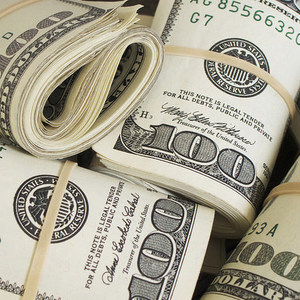People often speculate about whether the Federal Reserve will raise the interest rate or keep it where it is. The Federal Reserve is charged with the responsibility of keeping the U.S. economy on track, and it has the power to raise and lower the interest rate as well as create money. That’s just what it did in response to the financial crisis of 2008—it created three trillion dollars to prop the economy up. Now that the economy has more or less recovered, all that money poses a threat. Listen to this story to find out why and to learn what the Federal Reserve intends to do about it.
Listen to the story
AUDIE CORNISH: The Federal Reserve is the one institution with the power to create money out of thin air. And after the financial crisis, the Fed did a lot of that. It created more than $3 trillion to try to lower interest rates and help the economy. Now that things are looking better, this would normally be the time to suck that money back out of the economy so it doesn’t cause inflation or bubbles. But, as David Kestenbaum with our Planet Money podcast explains, the Fed is not going to take the money out of the economy. Instead, it’s going to use a new trick to make that money disappear.
DAVID KESTENBAUM: Three-trillion dollars is a lot of money. You do not want to suck it out of the economy too quickly.
JOE GAGNON: It would be disruptive.
KESTENBAUM: This is Joe Gagnon, an economist at the Peterson Institute. He used to work at the Fed. And he says the Fed used a lot of that new money to buy mortgage bonds to help out homeowners. So to suck the money out the economy, the Fed would have to reverse that.
GAGNON: Trying to unload a lot of that quickly would shoot mortgage rates sky-high then they’d come crashing down and it would just be a mess.
KESTENBAUM: Instead, the Fed is going to try something it has not done before. It’s going to leave those trillions of dollars out in the economy but try to make the money in a sense invisible. A lot of the cash is sitting at banks, and the Fed is going to pay the banks to sit on it. It’s going to pay them interest on their extra cash. That will make the banks less likely to lend it out. It will be as if the Fed had taken the money out of the economy.
It does feel like a magic trick.
GAGNON: It is a bit of a magic trick, yes.
KESTENBAUM: Gagnon says the Fed could end up paying the banks $30 billion a year for basically doing nothing. Now, the banks won’t just get to pocket all the money. When the Fed starts paying the banks interest on the cash they have sitting around, the banks will probably also end up paying more interest to people with savings accounts. But Gagnon says the banks could end up profiting, which is a little awkward. Some of those banks, of course, helped get us into this mess in the first place. Now we’re going to pay them to do nothing? Is that fair?
DAVID BLANCHFLOWER: I’m not going there.
KESTENBAUM: This is David Blanchflower, economist at Dartmouth.
BLANCHFLOWER: I’m (laughter) not going there.
KESTENBAUM: (Laughter). Why not?
BLANCHFLOWER: Economists – I mean (laughter), fairness is not anything I know about. I mean, economists are not good at what’s fair, right? What’s the famous phrase? OK. The optimal allocation of resources may still be perfectly disgusting. Now try that on you. There’s a famous quote. Good try though. (Laughter).
KESTENBAUM: The truth is, whenever the Fed does anything, it helps some people and hurts others. When the Fed lowered interest rates, some people got great deals on mortgages. But people with money in savings accounts, they earned almost no interest. The Fed is supposed to be thinking about bigger things – keeping the entire economy on track. And this trick of paying banks to sit on cash, it’s been tried in other countries, but it has never been done on this scale. Remember, the Fed created over $3 trillion out of nowhere. We talked to a bunch of experts though, and they were all confident it will work.
GLENN HUBBARD: Well, it doesn’t worry me from a technical perspective.
KESTENBAUM: This is Glenn Hubbard, Dean of Columbia Business School, chaired the Council of Economic Advisers under President George W. Bush.
HUBBARD: The Federal Reserve has abundant tools to normalize monetary policy, both in interest rates and in the size of its balance sheet.
KESTENBAUM: I thought you might be the guy we would talk to who would have some worries about the giant pile of money that was out there and how they were going to eventually, you know, suck it back out.
HUBBARD: No. No.
KESTENBAUM: Hubbard’s worry is just that the Fed will wait too long before raising interest rates. He thinks the time is now, David Blanchflower thinks the Fed should wait a bit longer. David Kestenbaum, NPR News.
 © 2015 National Public Radio, Inc. Used with the permission of NPR. All rights reserved.
© 2015 National Public Radio, Inc. Used with the permission of NPR. All rights reserved. Vocabulary
- balance sheet – a financial statement of a business’s assets, liabilities, and owners’ equity on a certain date or over a certain period of time
- bond – a security issued by a company or government to borrow money; each bond represents a small portion of a large loan
- inflation – an increase in the price of goods and services over time accompanied by a reduction in the purchasing power of currency
- interest rate – the percent of a sum of money charged by a lender for the use of its money
- economic bubble – a rapid rise in the price of an asset to a level that exceeds the asset’s true worth
Listening Comprehension Questions
- Why would the Federal Reserve want to remove money from circulation?
- What is the predicted effect on interest rates of removing money from circulation?
- Who benefits from injecting money into the economy? Who benefits from removing money from the economy?
- Why does David Kestenbaum question whether it is fair that the banks will profit from the Fed’s plan to “make the money disappear”?
Discussion Themes
- To what extent were banks responsible for the 2008 financial crisis?
- How does raising or lowering the interest rate banks charge each other affect the banks’ customers?
Teacher’s Guide
Activate student knowledge: Tell students that the story they will listen to is about a response to the economic recession in 2015. Ask them what they know or remember about the 2008 financial crisis and its causes. Remind them that this economic disaster began with a radical downturn in U.S. home prices and ultimately affected the entire global financial market. Banks stopped lending, and this had a crushing effect on businesses and industries that rely on credit. Trade and industrial activity declined, and eventually the economy was declared to be in recession. Ask students if they’re aware of the impact of the recession on their families.
Introduce the story: The Federal Reserve will pay banks to “sit on” three trillion dollars that it pumped into the economy in response to the 2008 financial crisis. Listen to this story to find out why the Fed now wants to make that money to disappear and the effects their plan could have on the economy.
Active listening supports: Choose one of the following listening organizers to support student understanding as they listen to the story.
- The graphic organizer Pros and Cons will guide student listening as they take notes on the Fed’s plan to make three trillion dollars disappear from the U.S. economy.
- The Language Identification organizer allows students to follow along and track important phrases while listening to the story.
Sample answers:
Solution: Leave the three trillion dollars in the economy. Pros: interest rates may stay low, the economy will be flush with money Cons: the excess may lead to inflation or bubbles
Solution: Remove all three trillion dollars quickly. Pros: avoids inflation or a bubble Cons: mortgage rates will skyrocket and then plummet; the economy will suffer
Solution: Keep the money in the economy but make it less visible. Pros: not disruptive to the economy, much of the money is already sitting at the banks, paying interest to the banks will make them less likely to lend it, keeping the money out of the economy Cons: the banks could make $30 billion per year to do nothing, after some of the banks were complicit in the initial financial crisis
Paired Text: Use this 2017 article by Joseph E. Gagnon, There Is No Inflation Puzzle, to pair with this audio story. Have students compare and contrast the information learned from the text and the audio.
Reflect on the story: Take time for student reflection on the audio story and discussion questions to check for understanding. Ask students why the Fed wants to make that money to disappear and the effects their plan could have on the economy.


